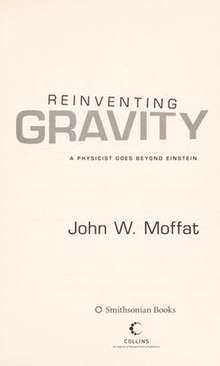Reinventing Gravity
Reinventing Gravity: A Scientist Goes Beyond Einstein is a science text by John W. Moffat, which explains his controversial theory of gravity.
 | |
| Author | John W. Moffat |
|---|---|
| Country | Canada |
| Language | English |
| Genre | Science text |
Publication date | 2008 |
| ISBN | 0-06-117088-7 |
Moffat's theory
Moffat's work culminates in his nonsymmetric gravitational theory and scalar–tensor–vector gravity (now called MOG).[1] His theory explains galactic rotation curves without invoking dark matter. He proposes a variable speed of light approach to cosmological problems, which posits that G/c is constant through time, but G and c separately have not been. Moreover, the speed of light c may have been much higher (at least trillion trillion times faster than the normal speed of light) during early moments of the Big Bang.[2] His recent work on inhomogeneous cosmological models purports to explain certain anomalous effects in the CMB data, and to account for the recently discovered acceleration of the expansion of the universe.
The theory is based on an action principle and postulates the existence of a vector field, while elevating the three constants of the theory to scalar fields. In the weak-field approximation, STVG produces a Yukawa-like modification of the gravitational force due to a point source. Intuitively, this result can be described as follows: far from a source gravity is stronger than the Newtonian prediction, but at shorter distances, it is counteracted by a repulsive fifth force due to the vector field.
STVG has been used successfully to explain galaxy rotation curves,[3] the mass profiles of galaxy clusters,[4] gravitational lensing in the Bullet Cluster,[5] and cosmological observations[6] without the need for dark matter. On a smaller scale, in the solar system, STVG predicts no observable deviation from general relativity.[7] The theory may also offer an explanation for the origin of inertia.[8]
Reception
The book was well received, although not uncontroversial, within scientific circles.[9] Publishers Weekly, in particular, said of Moffat:[10]
If his theory stands the test of time, Moffat will have created a paradigm shift not seen since Newton.
See also
- Einstein Wrote Back, another book by Moffat
References
- Moffat, J. W. (2006). "Scalar-Tensor-Vector Gravity Theory". Journal of Cosmology and Astroparticle Physics. 3: 4. arXiv:gr-qc/0506021. Bibcode:2006JCAP...03..004M. doi:10.1088/1475-7516/2006/03/004.
- Peter Calamai (27 November 2005). "Einstein's respectful heretic". Toronto Star. Archived from the original on 24 October 2012. Retrieved 21 May 2011.
- Brownstein, J. R.; Moffat, J. W. (2006). "Galaxy Rotation Curves Without Non-Baryonic Dark Matter". Astrophysical Journal. 636: 721–741. arXiv:astro-ph/0506370. Bibcode:2006ApJ...636..721B. doi:10.1086/498208.
- Brownstein, J. R.; Moffat, J. W. (2006). "Galaxy Cluster Masses Without Non-Baryonic Dark Matter". Monthly Notices of the Royal Astronomical Society. 367: 527–540. arXiv:astro-ph/0507222. Bibcode:2006MNRAS.367..527B. doi:10.1111/j.1365-2966.2006.09996.x.
- Brownstein, J. R.; Moffat, J. W. (2007). "The Bullet Cluster 1E0657-558 evidence shows Modified Gravity in the absence of Dark Matter". Monthly Notices of the Royal Astronomical Society. 382: 29–47. arXiv:astro-ph/0702146. Bibcode:2007MNRAS.382...29B. doi:10.1111/j.1365-2966.2007.12275.x.
- Moffat, J. W.; Toth, V. T. (2007). "Modified Gravity: Cosmology without dark matter or Einstein's cosmological constant". arXiv:0710.0364 [astro-ph].
- Moffat, J. W.; Toth, V. T. (2008). "Testing modified gravity with globular cluster velocity dispersions". Astrophysical Journal. 680: 1158–1161. arXiv:0708.1935. Bibcode:2008ApJ...680.1158M. doi:10.1086/587926.
- Moffat, J. W.; Toth, V. T. (2009). "Modified gravity and the origin of inertia". Monthly Notices of the Royal Astronomical Society Letters. 395: L25. arXiv:0710.3415. Bibcode:2009MNRAS.395L..25M. doi:10.1111/j.1745-3933.2009.00633.x.
- Maxfield, Clive (2010-09-30). "Book Review: Reinventing Gravity by John Moffat". EE Times. Retrieved 11 July 2013.
- "Reinventing Gravity: A Physicist Goes Beyond Einstein". Publishers Weekly. 2008-01-09. Retrieved 2013-07-11.